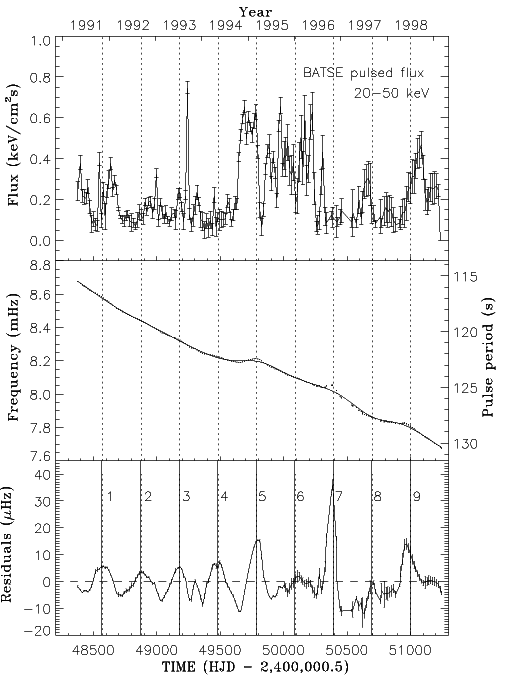X-ray Binaries
Long Term Intensity Variations in X-ray Binaries
The availability of a multi-mission archive spanning many years has been central to a number of important insights concerning the properties of X-ray binaries. Both high mass and low mass systems often show X-ray modulations on periods longer than the orbital period of the system. The mechanism that produces such super-orbital periods is still uncertain. Several processes have been proposed : a precessing accretion disk, neutron star precession, and feedback in the mass transfer process. The presence of a third member in some systems has also been suggested. Since these periods are often months to years, it is essential to monitor sources over many years. The HEASARC archive has proven to be essential for such studies. Wijnands et al. (1996, ApJ 473, L45) found a tentative ~78 day period in RXTE/ASM data from Cyg X-2 and then confirmed this period by examining archival data from the Vela-5B and Ariel V all-sky monitor data sets. The ratio of super-orbital to orbital period in Cyg X-2 is similar to the high mass systems (e.g.. LMC X-4). This, combined with the fact that Type I burst activity is not correlated with the long term modulation suggests that mass transfer feedback is probably not responsible for the periodic flux modulation; more likely a precessing accretion disk is responsible (Wijnands et al. 1996). More recently, Paul et al. (2000, ApJ 528, 410) have used archival RXTE, Ginga, Ariel V, Vela-5B and HEAO-1 data to investigate the long term intensity variations of Cyg X-2 and also LMC X-3. They find that more than one periodic or quasi-periodic component is almost always present in Cyg X-2 at 40 and 69 days but the 78 day period was not present in a longer RXTE ASM dataset.These results, as well as others (e.g. Kong et al. 1998, New Astron. 3, 301), highlight the unique strengths of easily accessible archival data: the ability to confirm or reject tentative identification of modulation periods in accreting binaries; the ability to make more sensitive post facto searches of older data sets when significant periods are discovered in new data; and perhaps most importantly, to maintain a long, ever increasing temporal baseline for variability studies.
Accreting Pulsars
Long term monitoring of the spin frequency of binary X-ray pulsars has led to a number of new insights into accretion onto magnetized neutron stars. The capability of BATSE to monitor the frequencies of a sample of bright pulsars led to the realization that torque reversals are common and that the magnitudes of the spin-up and spin-down torques are almost the same and moreover, are consistent with those expected from simple theoretical estimates for magnetized neutron stars (see Bildsten et al. 1997, ApJS 113, 367; and references therein).BATSE data continue to be a valuable resource for the study of pulsars. For example, Cagdas & Baykal (2000, A&A 353, 617) have used archival BATSE data to investigate the relationship between X-ray flux and pulse frequency in three high mass binary pulsars, Vela X-1, GX301-2, and OAO 1657-415. They find a strong correlation between specific angular momentum and torque. This, and the lack of any correlation between the pulse frequency derivative and flux, supports the idea that the accretion geometry changes continuously in a manner consistent with hydrodynamic simulations (Blondin et al. 1990, ApJ 356, 591).
Paul et al. (1997, A&A 320, L9) used BATSE archival data to study the relationship between torque and luminosity in the X-ray pulsar GX 1+4. They find a positive correlation. However, changes in the pulse period were found to lag the flux changes by ~6 days. Since this is much longer than any characteristic time-scale in the vicinity of the neutron star, they argue that the delay may be due to internal properties of the neutron star, perhaps a manifestation of the crust-core coupling time. The availability of the BATSE data in the HEASARC archive, along with scientific expertise to maintain them, will ensure many more such studies.

BATSE archival data for GX1+4 from Pereira et al. (1999)
Evidence for a ~304-day periodicity in the spin history of the accretion-powered pulsar GX1+4 that is most probably associated with the orbital period of the system has been obtained using archival data from BATSE (Fig. 8). Attempts over the last 20 years to find the orbital period of GX 1+4 by Doppler shifts of the pulsar pulse timing or optical lines had been inconclusive. For the X-ray timing measurements, the accretion torque magnitude is much larger than the expected orbital Doppler shifts, and the torque fluctuations have significant power at the time-scales comparable to the expected binary period (Chakrabarty 1996). Pereira et al. (1999, ApJ 526, L105) have derived a period for GX1+4 of 303.8 +- 1.1 days, making it the widest known low-mass X-ray binary system by more than an order of magnitude. A likely scenario for this system is an elliptical orbit in which the neutron star decreases its spin-down rate (or even exhibits a momentary spin-up behavior) at periastron passages due to the higher torque exerted by the accretion disk onto the magnetosphere of the neutron star.
|
Stars |
Science Introdution |
Cataclysmic Variables |
